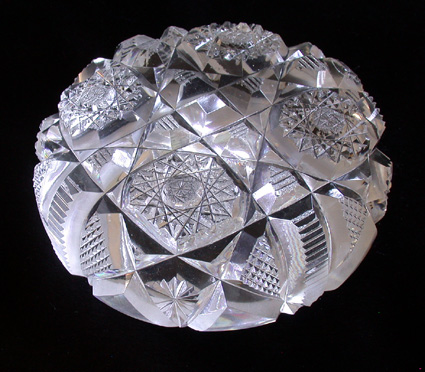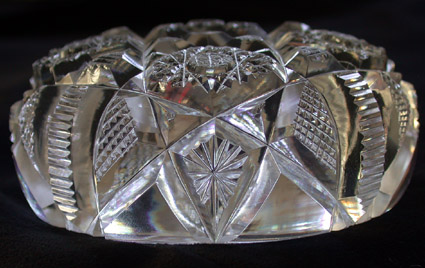
Paperweights as cut-glass accessories for the writing table can be found, although infrequently, in several companies' trade catalogs, from the third quarter of the nineteenth century through the first quarter of the twentieth. As such they should be considered to be standard items, not whimsies.
The variety of paperweight styles exhibited by paperweights of this period is considerable. Some are all-glass while others have metal handles. Of the former group, the examples most commonly found today are probably those thick rectangular slabs that have been cut and decorated to resemble books. Often they are personalized with wheel-engraved monograms or dates.
The all-glass paperweight that is examined in this file, and illustrated in the following images, is unusual in that it has a round, cushion shape. The weight at first glance appears to be the cover of a tobacco jar, somewhat modified. However, it is concluded that the blank is probably unique and, most likely, was one that was used for paperweights exclusively.
The weight is deeply cut in an Arcadia-type lozenge pattern (Pearson's terminology). Here the pentagons of the pattern are step-cut (prisms) instead of having Pearson's strawberry (fine) diamonds. They partially frame four 16-pt hobstars that have tiny 12-pt Brunswick stars on their hobnails. The deep cuts continue down the weight's side and form the following: eight triangular areas cut to sharp points (all of which are chipped); eight triangular areas filled with strawberry (fine) diamonds); four quadralaterals that have 16-pt single stars; and eight quadralaterals that are uncut.
TOP VIEW:

PROFILE VIEW:

The weight's base has a large and shallow ground and polished pontil with a diameter of 3.25". As can be seen in the following image the pontil contains a copper-wheel engraved monogram (three letters in elaborate script). The pontil area itself is framed by a 0.38" wide basal ring that shows intense wear. The glass-metal is of high quality with the result that the engraved monogram appears to be "floating" on the surface of a crystal-clear pond with the top cutting shining silver-like on the bottom of the pond. Additionally, this image gives a false impression that the weight is hollow. It is not.
BOTTOM VIEW:

The weight does not have significant chips. However, as indicated by the basal ring, it must have been in regular use for some time, and, as a result, there is also overall wear on the weight's upper surface in the form of hundreds (thousands?) of pin-head nicks. They show up on the photos but only under magnification. It is evident that the owner of this weight probably preferred, at some time in the past, to view it bottom-up. This would have been the cause of the surface wear on the weight's top (which was then its bottom, temporarily). All of this wear can be removed, but the question is: Should such a restoration be undertaken?
Magnum paperweight, c1900. D = 3.5" (8.9 cm), H = 1.38" (3.5 cm), wt = 1.1 lb (0.49 kg). Manufacturer unknown. Purchased for $26 in 2007 at an antiques shop on Market Street, Corning where it was offered as a whimsy. Photographed in as-found condition. It is estimated that it might cost as much as $200 to have the weight restored to its original condition.
Updated 1 May 2007